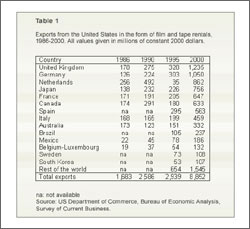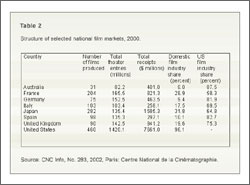Hollywood in the Era of Globalization
Hollywood in the Era of Globalization

From the early years of the twentieth century, right down to the present, the United States has been the world's major commercial producer of motion pictures. According to the US Economic Census, motion picture and video production in the United States as a whole generated revenues of $20.15 billion in 1997, with Hollywood alone being responsible for close to 60% of this total. The long-standing success of Hollywood can be accounted for in terms of the competitive advantages generated by its unrivalled technical and organizational capacities (in the form of a dense regional cluster of specialized but complementary producers) and its unique pool of talent drawn from many different countries (Scott, 2000). Like numerous other dynamic industries today, Hollywood is caught up in an insistent - and problematical - process of globalization. Indeed, the commercial weight and cultural impact of Hollywood films is now felt in virtually every corner of the world.

In the year 2000, the gross domestic box office receipts for motion pictures in the United States was $7.66 billion, an increase (in constant dollar terms) of 28.3% from $5.97 billion in 1986. Rental fees generated by exports of film and tape amounted to $8.85 billion in 2000 (see Table 1) as compared to $1.68 billion in 1986 - an increase of 426%. Thus not only have exports grown much more rapidly than domestic markets over the last fifteen years or so, but they now also exceed domestic box-office receipts by a considerable margin. By far the main importers of Hollywood products are European countries. The United Kingdom, Germany, and the Netherlands alone account for 35% of all rental exports from the United States. Japan and Canada, too, are major importers, as are Australia, Brazil and the Republic of Korea.
The most important Hollywood production companies, or "majors," maintain extensive distribution and marketing networks in North America as well as in other countries (1). Through their multinational operations the majors directly control distribution systems in all their principal foreign markets, as well as in many more secondary markets. United International Pictures, for example, is a joint venture of Universal and Paramount, which owns distribution facilities in as many as 37 different countries including Britain, France, Germany, the Netherlands, Australia, and Japan, as well as in less lucrative territories like Hungary, Chile, Peru, the Philippines, and Thailand. Twentieth-Century Fox owns 21 foreign distribution facilities in an equally diverse set of countries. In territories where the majors do not actually own a distribution network outright they frequently enter into joint ventures or long-term agreements with local distribution companies. American films always garner at least half, and sometimes more than two-thirds, of total box-office receipts in major foreign countries (see Table 2). This level of success on export markets can be ascribed not only to the prowess of American multinational media corporations in disseminating the products of Hollywood across the globe, but also to their unique ability to make big-budget films that appeal powerfully to popular tastes in many different cultures.

That said, exports of Hollywood motion pictures have always depended in significant ways on strong political support from Washington. Federal bureaucracies have continually pressed foreign governments to open their doors more widely to American films, with beneficial effects not only in terms of export earnings, but also of the direct and indirect developmental impacts on Hollywood itself. Over the years, Hollywood has received abundant help from the US State Department, the Commerce Department, and other agencies of federal government in promoting its products abroad.
At least since the Second World War, the interests of Hollywood and the aims of Washington have consistently coincided on the external trade front even when there has been less accord on the domestic front (Segrave, 1997). One particularly notable case of this convergence of interests is represented by the Marshall Plan for Europe (1948-51) whose provisions linked levels of aid directly to recipients' willingness to accept imports of US motion pictures (Guback, 1969). This requirement functioned as a means of stimulating American exports at large (by helping to re-shape overall tastes and preferences in foreign markets), and as an ideological weapon at a time when significant segments of Western European societies seemed ready to align themselves politically with the Soviet Union.
More recently, as globalization has started to intensify, the United States government has been actively promoting free trade agendas generally, and unhampered trade in cultural products in particular. This stance resulted in the confrontation between the United States and Europe (led by France) over trade in audiovisual products at the time of the GATT (now WTO) negotiations of 1993. The European position prevailed at the end of this particular round of negotiations, with a "cultural exception" being asserted such that each country was allowed to set up trade restrictions in motion pictures and television programs according to its own cultural preferences. There is every likelihood, however, that the US position will ultimately win the day in the newly constituted WTO with its avowed aim of further trade liberalization.
In the never-ending effort to advance the interests of Hollywood in various forums of national and international deliberation, the majors are jointly represented by the Motion Picture Association of America (MPAA), which plays a critical role as an industry mouthpiece and lobbying organization. Symptomatically, the Association has offices in Washington, DC, as well as in Southern California. The MPAA preaches an aggressive doctrine of free trade, and it was notably active behind the scenes at the GATT negotiations in 1993. The MPAA is also the parent organization of the MPA (Motion Picture Association), formerly known as the MPEA (Motion Picture Export Association), established in 1946 as a legal cartel under the provisions of the Webb-Pomerane Export Trade Act. Outside the United States, the MPA has offices in Brussels, Rome, New Delhi, Rio de Janeiro, Singapore, Mexico City, Toronto, and Jakarta, and from these bases it carries out its basic mission of promoting Hollywood motion pictures, protecting intellectual property rights, and asserting the goals of the industry generally in foreign markets.
Independent motion-picture distributors are represented by AFMA (the American Film Marketing Association), an active and influential organization founded 1981. AFMA's membership roster of over 130 firms is composed primarily of independent distributors and allied firms based in Hollywood, but a large proportion is made up too of firms from other parts of the country and from abroad. Like the MPAA, AFMA is concerned to advance the interests of its members in regard to trade and public relations, with a special emphasis on issues of arbitration, piracy, marketing, and tracking members' earnings from foreign sources. AFMA also organizes the American Film Market, an annual event in Santa Monica representing the largest motion-picture trade event in the world, attracting over 7,000 people from over 70 different countries. The American Film Market has come to play a major role as a focal point for the promotion of independently-made Hollywood films.
The steady globalization of Hollywood as an expression of both market forces and US government action on international trade issues has, of course, engendered numerous clashes and disputes. Some of these are based on purely commercial differences of interest; some are focussed on cultural collisions of one sort or another; and some, perhaps the majority, are a complex mixture of the two as reflected in the audiovisual policies of countries like Canada, China, France, and South Korea. The official line of the MPAA and the US Department of Commerce is that international trade in cultural products should proceed in as open and as free a manner as possible, and should not be subject to any special restrictions. This line, however, overlooks the circumstance that unlike wheat or coal, cultural products are also intimately bound up with matters of social identity and consciousness. Conflicts over these matters as a consequence of cultural products flowing from one society to another are to be expected and need to be dealt with on their own terms. A rhetoric of pure market ideology inevitably misses the crucial point here. It can be plausibly argued that even in the United States governmental engagement with the content of motion pictures has been averted only because of the self-regulation of the industry, dating from the time of the promulgation of the Hays Code in 1930 (2).

Given the appeal of United States' entertainment products to mass audiences all over the world, the country will probably continue to maintain a strong lead as an exporter of motion pictures for the foreseeable future. There are signs, however, that some important shifts may be in the offing. For one thing there has been a very significant rise in runaway production activities from Hollywood to cheaper locations in Canada, Mexico, and further afield. Hitherto, this phenomenon has not posed very much of a threat to the basic role of Hollywood as a center of creativity and deal-making in the motion-picture industry, though there are signs that the outflow of capital and work may be helping to stimulate the rise of competitor film industries (for example in Toronto and Vancouver). At the same time, and independently of runaway activities from Hollywood, dynamic centers of audiovisual production in many different countries are now also beginning to contest and recontest global markets. Producers in places like London, Paris, Beijing, Hong Kong, Tokyo, Mexico City, Mumbai/Bollywood, Sydney, and so on, are all in various ways making efforts to improve their market performance and to compete internationally. Similarly, American media conglomerates are no longer the unchallenged champions of cultural globalization that they once were. With the rise of large multinational media corporations based in Europe and Japan, the global cultural landscape is becoming considerably more complex, and competitive pressures are mounting steadily. Some of these corporations are also acquiring significant stakes in American film, television, music, publishing and other cultural-products industries. For the moment, the Hollywood motion-picture industry remains unmatched in its commercial vigor and market reach. If the history of other formerly triumphant industrial juggernauts - from Manchester to Detroit - is any guide, however, the continued leadership of Hollywood is by no means automatically assured. In spite of Hollywood's acquired competitive advantages, it cannot be ultimately free from economic threats emanating from elsewhere. This is especially true in view of the often unpredictable shifts in the structure of consumer preferences for motion-picture entertainment.
With the advent of new electronic distribution technologies, Hollywood is also facing a major paradigm shift that may well have important impacts on the way it and its competitors do business in the future. These technologies will eventually make it possible to dispatch films directly and cheaply to individual purchasers, thereby in principle opening up the market to more effective contestation by smaller independent production and distribution companies from a wider circle of locations. Thus, on the one hand, the advent of motion-picture distribution by means of the internet will no doubt give rise to a great increase in the amount of cinematic material available to consumers, thereby broadening the market and almost certainly making inroads on audiences for blockbuster films. On the other hand, consumers' choices will in all probability continue to be molded significantly by a limited number of firms with the resources to mount extravagant marketing and promotional campaigns, so that even if the audiences for blockbusters stabilize or shrink compared to current levels, the phenomenon of large-scale revenues on products at the top end of the market is likely to continue. Equally, there is much evidence to suggest that foreign film industries might be re-entering the competitive foray, not only on the basis of revivified local production clusters and fresh competitive strategies, but also thanks to enhanced distributional and marketing capacities aided by the rise of home-grown media conglomerates. Hollywood can never rest on its laurels.
Footnotes:
(1) The majors are MGM, Paramount, Sony-Columbia, Twentieth Century Fox, Universal, Walt Disney, and Warner Brothers.
(2) Which is not to overlook the circumstance that governmental scrutiny has in fact often been intense, in episodes ranging from the House UnAmerican Activities Committee hearings in the late 1940s and early 1950s to recent congressional inquiries into the role of violence in films and television programs.
References:
Guback, T. H. (1969). The International Film Industry: Western Europe and America since 1945. Bloomington: Indiana University Press.
Scott, A. J. (2000). The Cultural Economy of Cities, London: Sage Publications.
Segrave, K. (1997). American Films Abroad: Hollywood's Domination of the World's Movie Screens. Jefferson, NC.: McFarland.
Allen J. Scott is Director of the Center for Globalization and Policy Research at the University of California, Los Angeles.